Care of the newborn lamb
Learn about safe handling of newborn lambs. This technical information is for Ontario sheep producers.
ISSN 1198-712X, Published December 2021
Download PDFIntroduction
The profitability of a meat sheep enterprise depends on the number of lambs sold either for meat or as breeding stock. The number raised to market reflects the complete management of the flock throughout the year. One of the critical points in this management cycle is lambing. This fact sheet discusses important considerations to improve survival of newborn lambs.
Lambing facilities
Sheep can be lambed outdoors on grass with no barn facilities in the spring, but many operations lamb indoors due to alternate lambing times, weather, predation or parasite concerns. In indoor systems, a draft-free but well-ventilated building should be used for lambing. Indoors, ewes have less space and cannot easily find space away from other ewes, so lambing or claiming pens should be available to promote bonding between the ewe and her lambs (Figure 1).
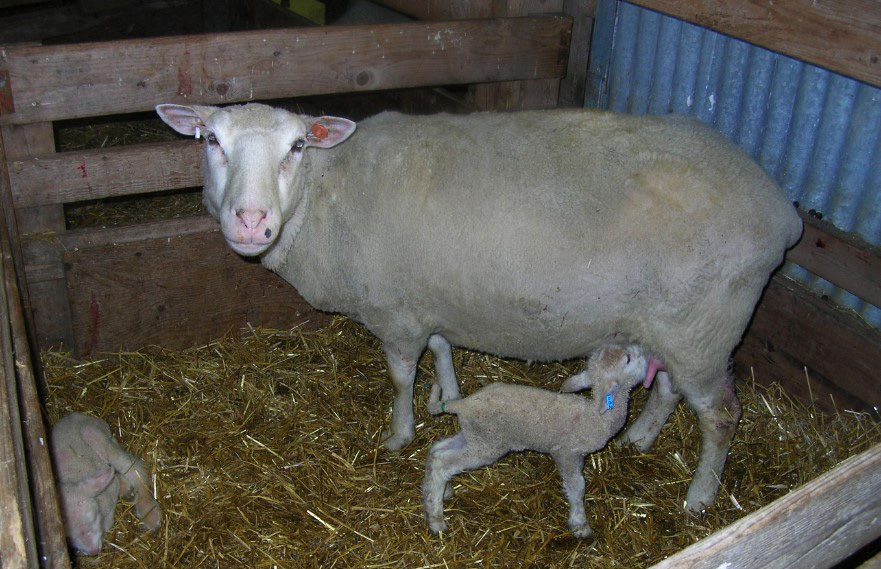
Lambing pens allow the shepherd to easily monitor ewes and lambs to ensure adequate nursing and ease of lamb processing. The ewe can be put into this pen when close to lambing, or after the lamb has been dropped. The pen should be about 1.5 m2 with a corner divided off to give the lamb a safe area from the ewe. Once the lambs are vigorous and all treatments completed, the ewe and her lambs can be let out into a larger hardening pen in groups of 4–12 ewe/lamb sets for monitoring for several days before grouping into a large pen. Lambing pens must be cleaned and re-bedded after each ewe to reduce bacteria build-up and disease transmission. Ewes with single lambs may spend little time in a lambing pen, whereas ewes with multiple lambs may spend several days in a lambing pen.
Preparing for lambing
To be prepared for lambing you will need a hospital area to care for compromised newborn lambs, two supply kits, as well as additional lambing supplies. One supply kit contains supplies to assist the ewe at lambing (see companion fact sheet Assisting the ewe at lambing), and the other kit contains the supplies to process each newborn lamb.
The lamb processing kit should contain:
- record keeping book
- suitable syringe and needles
- iodine solution for dipping navels
- vitamin E/selenium preparation
- ear tags and applicators and/or tattooing pliers
- tail docking rings or cutter
Other basic supplies that should be on hand:
- warming box, heating pad and/or heat lamp
- clean newspaper for warming box
- kettle for boiling water
- frozen and/or powdered colostrum
- milk replacer
- stomach tube and squeezable bottles
- nipples and milk feeding bottles
- digital thermometer
- sterile 60-mL syringes
- sterile 18-gauge or 20-gauge needles
- sterile 50% dextrose
- livestock spray or crayon marker to identify at‑risk lambs
- white board for notes and reminders
The hospital area should be close to your basic supplies, running water and a warming facility. Examples of warming facilities include:
- warming box – a box that allows circulation of warm air around the lamb (Figures 2 and 3)
- water bath – immersing the lamb in warm water will warm the lamb most quickly, but requires holding to prevent drowning and immediately towel drying to prevent further chilling, so it requires the most labour
- heating pad/radiant heat – both will warm the lamb, but there is a risk of burning if used improperly
- heat lamp – not recommended for severe hypothermia, as it only warms one side of the lamb, but can be used for mild hypothermia (37°C–39°C)
A warming box or water bath are the preferred methods of warming a lamb experiencing moderate to severe hypothermia. The hospital area should be used to store your colostrum and supplies needed to revive hypothermic and/or hypoglycemic newborn lambs.
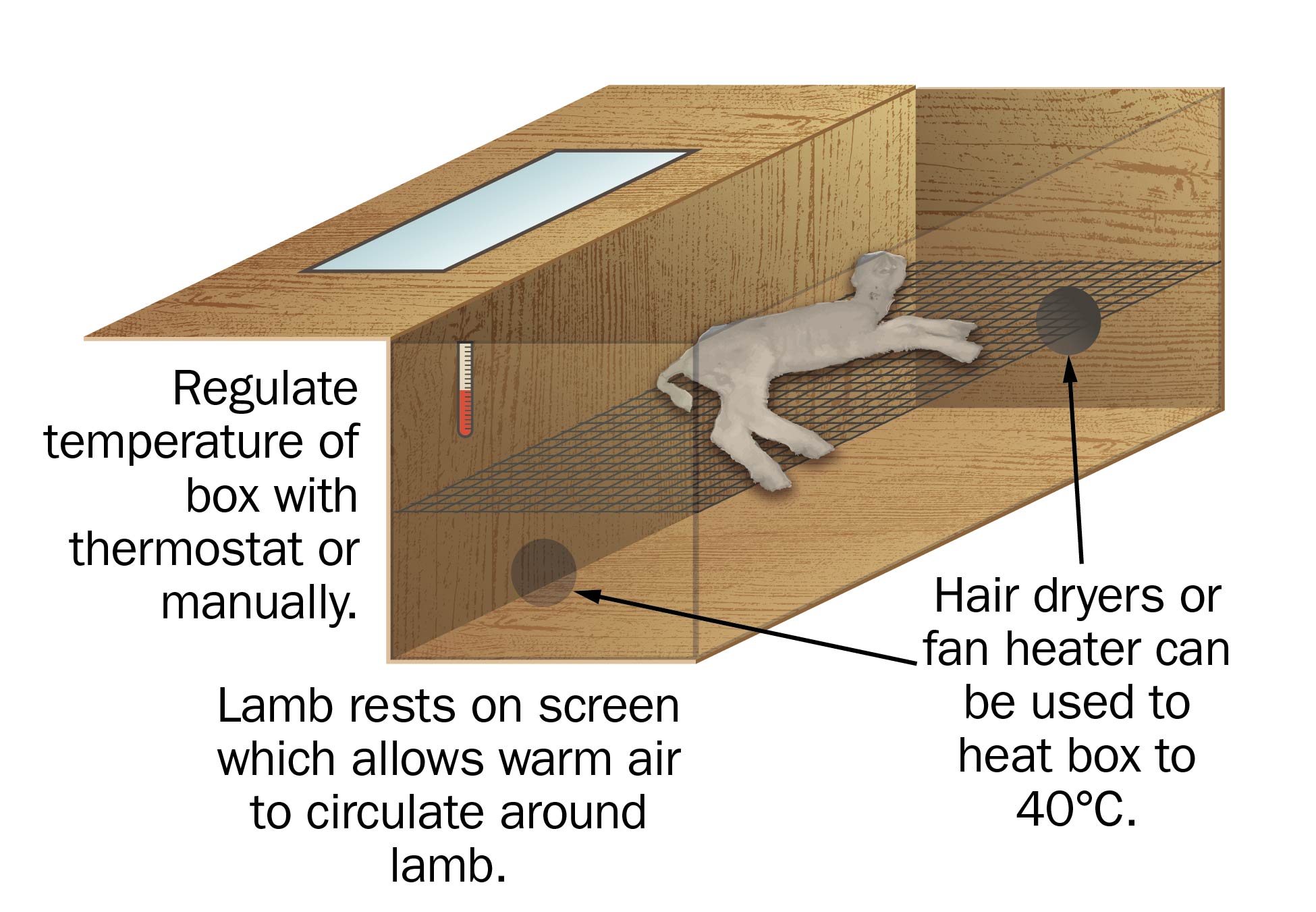
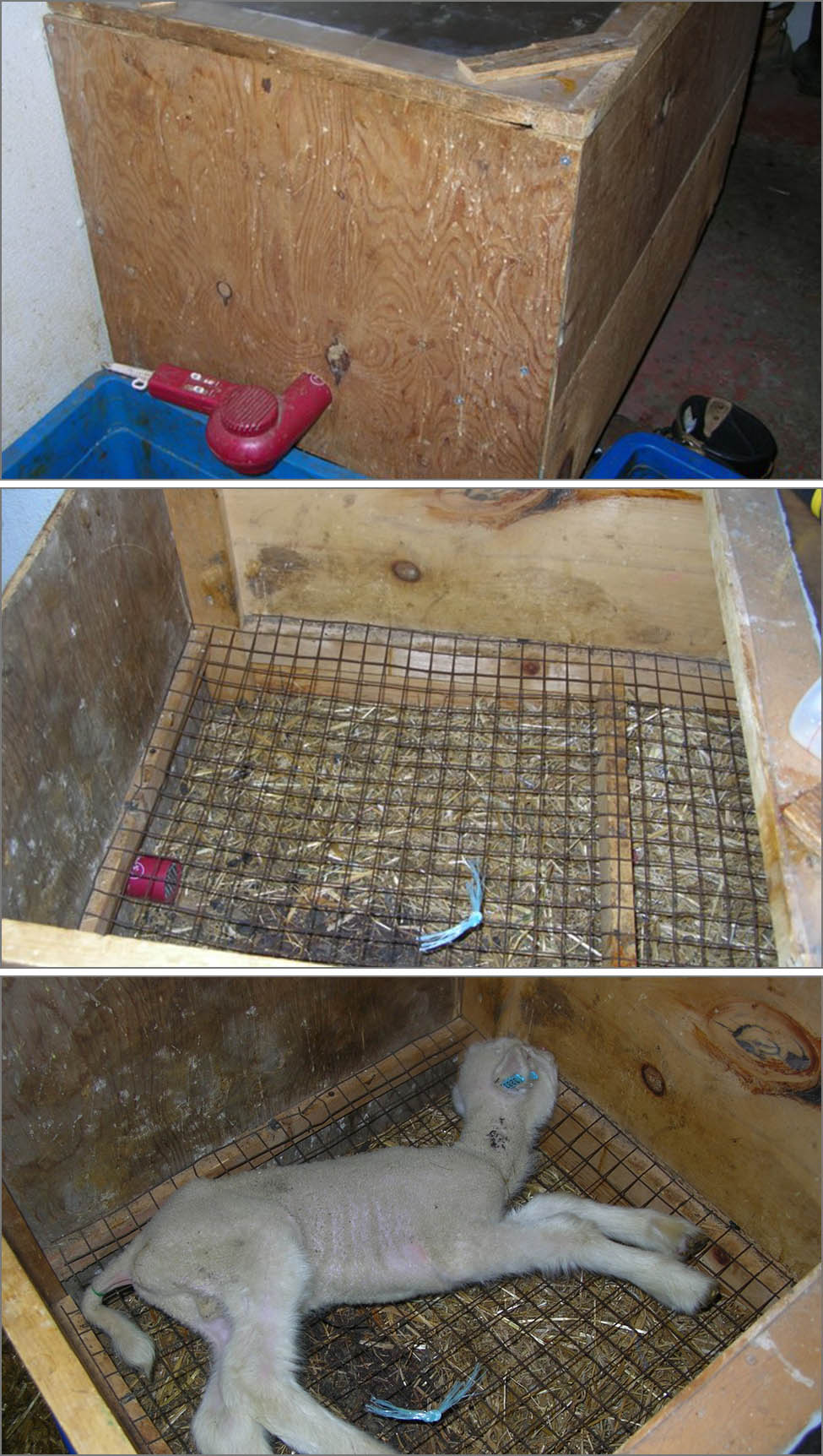
Lambing
The lamb should start breathing at birth, but it may need help. Check that there is no placenta covering the nostrils or mouth. A gentle rub over the chest with a towel or straw whisk, tickling the inside of the nostrils with a piece of straw or blowing into the nostrils (do not allow your lips to come in contact with the wet lamb while doing this) will often stimulate breathing. A lamb resuscitator can also be purchased from sheep supply companies to inflate the lamb’s lungs. Ewes should be monitored to ensure that lambs are dried off quickly after lambing to reduce the risk of chilling. Lambs from maiden or prolific ewes are the most vulnerable. The lower the surrounding temperature, the faster a lamb loses body heat and the greater the risk of chilling.
Colostrum
Ensure the ewe has colostrum. Colostrum feeding at birth is the most critical management point in the lamb’s entire life. The longer colostrum consumption is delayed, the poorer the lamb’s ability to utilize it and receive important antibodies from the ewe.
If there is concern that insufficient colostrum has been consumed from the ewe, administration of additional colostrum should be considered. Ideally a lamb should receive 50 mL/kg of bodyweight of its own mother’s colostrum, within 1 hour of birth and an additional 200 mL/kg spread over three more feedings within the first 24 hours of life. Cow colostrum can be used but is less preferable and 30% more must be fed, equivalent to five feedings in the first 24-hour period. Johne’s disease can be spread through infected cow colostrum, so only use colostrum from Johne’s-tested cows. Johne’s disease is a contagious and chronic infection that affects the small intestine of ruminants. It is usually fatal.
Collect and freeze colostrum in 500-mL batches so that you have colostrum available when needed. To feed frozen colostrum, thaw in a water bath at 35°C, never in a microwave as this will denature complex proteins and destroy the antibodies in the colostrum. Or mix powdered colostrum according to the label directions using sterile water.
Fostering
For a variety of reasons, a lamb may need to be fostered onto another ewe. If possible, fostering should be considered first before artificial rearing. See the OMAFRA fact sheet Artificial Rearing of Lambs for more information on artificial rearing. Fostering should be done as soon after birth as possible, ideally when the lamb is still wet. If fostering from a set of triplets, choose the strongest lamb. Keep the ewe and the fostered lamb in a lambing pen until you are certain that the adoption has succeeded. To persuade the ewe to accept the lamb, several techniques can be used:
- rub the lamb in the placenta of the ewe’s own lamb
- if you are replacing a dead lamb, put its skin onto the adoptee
- put the ewe into a head gate to prevent her pushing the lamb away when it attempts to suckle
Recognizing and treating hypothermia
Many newborn lambs die, not from disease, but from chilling. This is especially true in Ontario, where many lambs are born in the coldest months of the year to be ready for the Easter market. The best way to recognize hypothermia is to take a rectal temperature (Figure 4). Look for any lambs that are hunched over or that appear dull or weak and check their rectal temperature using a digital thermometer that measures subnormal body temperatures (as low as 20°C). The normal temperature of a lamb is 39°C–40°C, and the lower the rectal temperature, the more severe the hypothermia. The sooner hypothermia is identified and remedied, the better the lamb’s chance of survival.
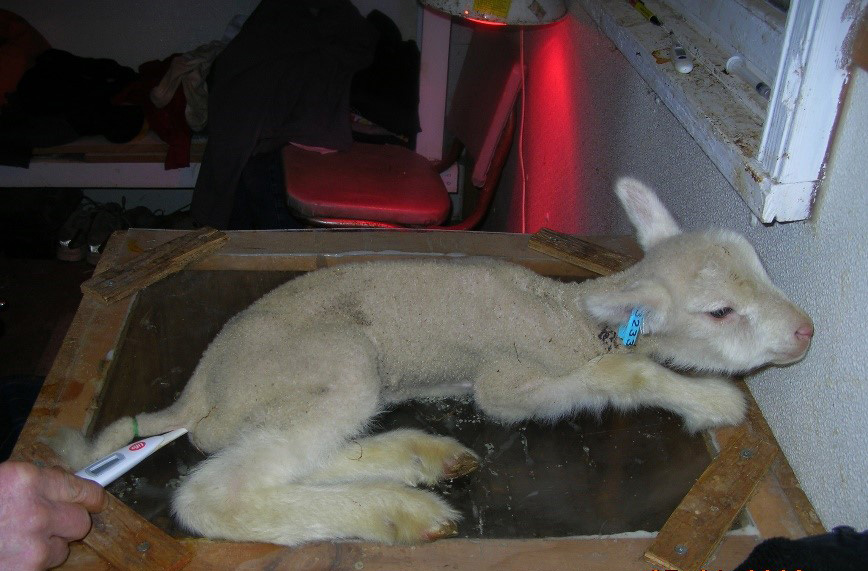
Stages of hypothermia
Treatment varies with the degree of hypothermia, as indicated by the rectal temperature. The basis of treatment of the hypothermic lamb is to warm it up and provide a source of energy to start heat production again.
Mild hypothermia (rectal temperature 37°C–39°C)
The lamb is weak, depressed and appears empty but may be able to stand. It should be moved into shelter, dried off if wet and fed colostrum by stomach tube. Feed 50 mL/kg of bodyweight slowly over 5–10 minutes and then feed 200 mL/kg bodyweight spread over three more feedings in the first 24 hours. The lamb can stay with the ewe provided she is in a sheltered area and the lamb is suckling. Once the lamb’s rectal temperature is normal, they can be returned to the flock.
Small lambs less than 1.5 kg at birth may have insufficient fat reserves to initiate heat production, even with colostrum, and should be fed a 20% dextrose solution (50 mL/kg of bodyweight) by stomach tube 1 hour after the first colostrum feeding. Lambs under 2 kg
Moderate to severe hypothermia (rectal temperature below 37°C)
Once the rectal temperature falls below 37°C the lamb may no longer have energy reserves in addition to being hypothermic. The treatment plan will differ depending on the age of the lamb and whether the lamb has a suckle reflex (is able to swallow). In all cases, remove the lamb from the ewe and dry off if wet. Lambs over 5 hours old may not have energy reserves. Failure to provide energy before warming will cause the lamb to convulse and die. See Table 1 for treatment protocols that are dependent on the age and suckling ability of the lamb.
Once the lamb has been revived to a rectal temperature over 37°C, has a suckle reflex and has received colostrum, it can be kept in a hospital pen with a heat source (such as a box in warm environment) and fed until strong and maintaining a normal temperature of 39°C (Figure 5). Once strong, return the lamb to its dam, but make sure it is nursing by identifying it with livestock paint or marker. The lamb may need to be artificially reared if it fails to thrive or is rejected from the ewe.
| Scenario | Symptoms | Treatment |
|---|---|---|
| Less than 5 hours old, with suckle reflex | Weak, empty, depressed, may be unable to stand | Place in warming box until rectal temperature > 37°C Administer warm colostrum by stomach tube (feed 50 mL/kg bodyweight), additionally, feed 200 mL/kg body weight spread over three more feedings within the first 24 hours |
| More than 5 hours old, with suckle reflex | Tucked up, empty appearing and depressed | Administer warm colostrum by stomach tube (feed 50 mL/kg bodyweight) prior to warming Place in warming box until rectal temperature is > 37°C Administer warm colostrum by stomach tube again (feed 50 mL/kg bodyweight), additionally, feed 200 mL/kg bodyweight spread over three more feedings within the first 24 hours |
| More than 5 hours old, no suckle reflex | Lamb is often unable to stand | Do not attempt to stomach tube as colostrum will be deposited in the lungs, which will kill the lamb The lamb must first be injected with a sterile solution of warm 20% dextrose (10 mL/kg bodyweight), into the abdominal cavity (see administering dextrose solution below) Place in warming box until rectal temperature is > 37°C Once revived and with a suckle reflex, administer warm colostrum by stomach tube (feed 50 mL/kg bodyweight), additionally, feed 200 mL/kg bodyweight spread over three more feedings within the first 24 hours |
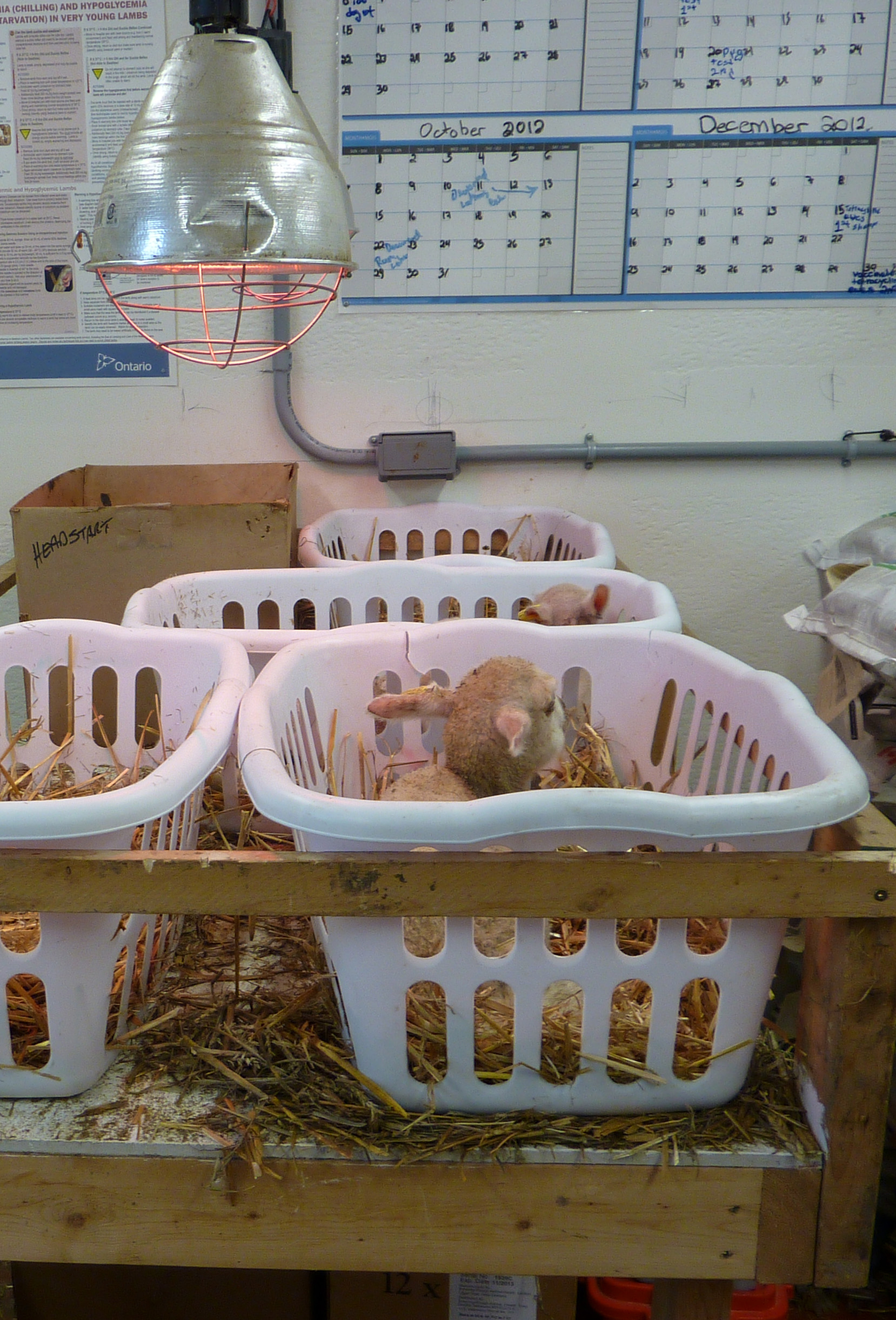
Feeding colostrum by stomach tube
Feeding colostrum by stomach tube may be necessary when lambs are weak or lacking a suckle reflex (Figure 6). Tubing lambs is an important skill for every producer to be familiar with. Ask your veterinarian to demonstrate if you need assistance.
- Sit with the lamb restrained on your lap and measure the tube.
- Pass the tube into the side of the mouth in the space between the front and side teeth.
- Using gentle pressure, slide the tube into the esophagus and down to the stomach.
- The tube will move easily, any resistance or coughing indicates that the tube has entered the windpipe and it should be removed immediately.
- The accidental passing of colostrum into the lungs will result in the death of the lamb due to aspiration pneumonia.
- The esophagus is behind/beside the windpipe on the lamb’s left. By placing your fingers on each side of the lamb’s throat, you should be able to feel two tubes while sliding the stomach tube in; you will feel the windpipe and the tube passing down the esophagus.
- Slowly administer the warm colostrum over 5 minutes, using either a 60-mL feeding syringe or a 250-mL squeeze bottle.
- Crimp the end of the tube over prior to removing to prevent aspiration.

Administering dextrose solution
Intraperitoneal injections of dextrose solution are used to revive lambs with severe hypothermia. Both conscious and comatose lambs experiencing chilling can be injected in this manner. Ask your veterinarian to teach you this procedure (Figure 7).
- With a sterile 60-mL syringe, draw up 20 mL of sterile 50% dextrose using a sterile needle.
- Boil clean water and draw up 30 mL of this water into the same syringe, to create 50 mL of warm (38°C–40°C) 20% dextrose solution.
- The dose is 10 mL/kg of bodyweight, so 50 mL is enough for a 5-kg lamb.
- Suspend the lamb vertically by the forelimbs.
- Use an 18–20 gauge (pink or yellow) 25-mm (1-in.) needle at the injection site, 2.5 cm below and to the side of the navel.
- Insert the needle at a 45° angle to the body wall, pointing towards the lamb’s pelvis. The internal organs will be pushed away by the needle and not damaged.
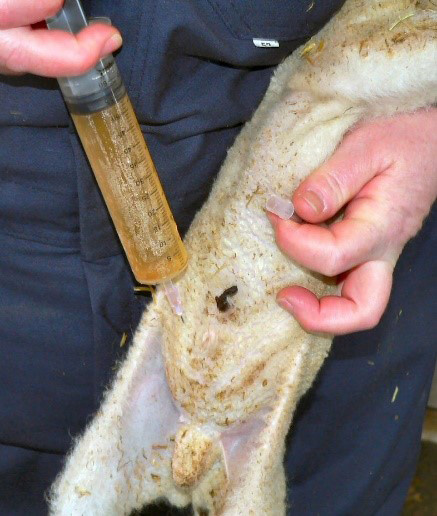
Processing newborn lambs
In the first few days of a lamb’s life, there are several procedures that may have to be completed. Perform navel dipping and injections as soon as possible after birth. It is recommended that you wait until the lamb has had adequate colostrum and maternal bonding time before procedures like tail docking and castration. Consult the Code of Practice for the Care and Handling of Sheep for specific requirements and recommendations for lamb processing procedures.
Injections
In Ontario, newborn lambs can be born selenium-deficient. They should be routinely injected with a vitamin E/selenium preparation at a dose recommended by your veterinarian. Read the label on the bottle for the route of injection, either subcutaneous or intramuscular. Always inject into the neck area, never into the muscles of the hindquarters.
Navel disinfection
The navel of the newborn lamb needs to be disinfected as soon after birth as possible. The untreated navel is an excellent route for infectious agents to enter the lamb, causing internal abscessation or joint ill. An iodine solution is the most common disinfectant. Use disinfectants according to the manufacturer’s guidelines. The disinfectant is either sprayed onto the navel or the navel is dipped in a small container of the solution. If dipping navels, replace the disinfectant solution after every tenth lamb.
Tail docking
Tail docking may be performed for health and hygienic reasons. It is used to reduce flystrike, where blowfly eggs hatch in manure-stained wool and feed on the flesh of the animal, as well as bacterial contamination of the carcass during processing. Tail docking is a painful procedure, and you should carefully consider whether it is necessary for your flock. For example, it may not be warranted for short-tailed or hair breeds, where flystrike is of less concern. If you decide tail-docking is needed, work with your veterinarian to develop protocols for reducing pain. Tails should be docked between the ages of 24 hours and 7 days. The tail can be removed with:
- electric or gas heated docker
- crush and cut device
- rubber ring
- rubber ring plus crushing device
The docked tail must cover the vulva in ewes and the equivalent length in rams. A good guide is to remove it between the tail bones just below the web on the underside of the tail.
Castration
Ram lambs may be castrated to reduce unwanted breedings and/or to maintain muscling if the lamb will not be marketed until after puberty. Carefully consider whether castration is necessary in your flock. Ram lambs are more efficient due to faster growth rates than wethers. Castration is not recommended if ram lambs will be slaughtered before puberty, or ewe and ram lambs will be managed separately past puberty.
Castration should be done between 24 hours and 7 days of age, according to the Code of Practice for the Care and Handling of Sheep. You should discuss the options for castration with your veterinarian to determine a strategy that minimizes pain and disruption to growth.
Identification
Lambs should be individually identified before they leave the lambing pen. Identifying individual animals is crucial for both flock management and traceability purposes. The method of identification can be temporary as an interim solution (such as livestock paint), but eventually permanent identification will be needed. Common permanent identification methods include tattoos, ear tags and ear notches. Proper hygiene practices, well-maintained application tools and appropriate restraint will reduce the potential for infections where the skin is broken during permanent identification. It is important to note that regardless of the identification method used on-farm, all Canadian sheep must be identified with an ear tag approved by the Canadian Sheep Identification Program before leaving the farm of origin. Use only tags that are designed for sheep and no more than two per ear. Position tags according to the manufacturer’s instruction to avoid blood vessels and interference with natural ear position.
Conclusion
Lambing is often the most challenging period of the sheep management cycle. Appropriate preparation and careful attention to many small details are critical for a successful lambing. Proper preparation and management during lambing, including ensuring appropriate colostrum intake, intervention to treat chilling and appropriately processing newborn lambs, will reduce mortality. Producers should discuss and review the farm lamb care plan with their veterinarian prior to lambing to ensure a good start for a successful market lamb crop.
This fact sheet was written by Erin Massender, small ruminant specialist, and Delma Kennedy, sheep specialist, with the Ontario Ministry of Agriculture, Food and Rural Affairs (OMAFRA). It combines the OMAFRA fact sheets Care of the newborn lamb and Hypothermia in newborn lambs, both written by Dr. S. John Martin, veterinary scientist, sheep, goat and swine, OMAFRA.